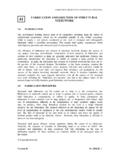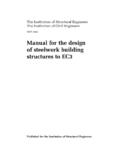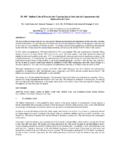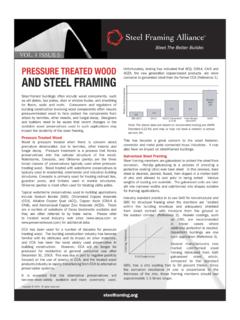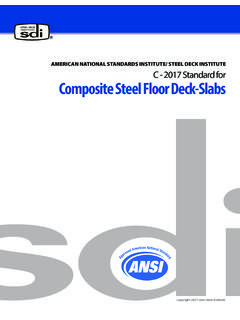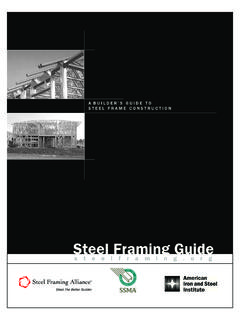Transcription of STEEL BUILDINGS IN EUROPE Single-Storey Steel …
1 STEEL BUILDINGS IN EUROPE Single-Storey STEEL BUILDINGS Part 2: Concept Design Single-Storey STEEL BUILDINGS Part 2: Concept Design 2 - ii Part 2: Concept Design 2 - iii FOREWORD This publication is a second part of a design guide, Single-Storey STEEL BUILDINGS . The 11 parts in the Single-Storey STEEL BUILDINGS guide are: Part 1: Architect s guide Part 2: Concept design Part 3: Actions Part 4: Detailed design of portal frames Part 5: Detailed design of trusses Part 6: Detailed design of built up columns Part 7: Fire engineering Part 8: Building envelope Part 9: Introduction to computer software Part 10: Model construction specification Part 11: Moment connections Single-Storey STEEL BUILDINGS is one of two design guides. The second design guide is Multi-Storey STEEL BUILDINGS .
2 The two design guides have been produced in the framework of the European project Facilitating the market development for sections in industrial halls and low rise BUILDINGS (SECHALO) RFS2-CT-2008-0030 . The design guides have been prepared under the direction of Arcelor Mittal, Peiner Tr ger and Corus. The technical content has been prepared by CTICM and SCI, collaborating as the STEEL Alliance. Part 2: Concept Design 2 - iv Part 2: Concept Design 2 - v Contents Page No FOREWORD iii SUMMARY vi 1 INTRODUCTION 1 Hierarchy of design decisions 1 Architectural design 2 Choice of building type 6 Design requirements 9 Sustainability 12 2 CASE STUDIES ON SINGLE STOREY BUILDINGS 14 Manufacturing hall, Express Park, UK 14 Supermarket, Esch, Luxembourg 15 Motorway Service station, Winchester, UK 16 Airbus Industrie hanger, Toulouse, France 17 Industrial hall, Krimpen aan den Ijssel, Netherlands 17 Distribution Centre and office, Barendrecht.
3 Netherlands 18 3 CONCEPT DESIGN OF PORTAL FRAMES 19 Pitched roof portal frame 20 Frame stability 22 Member stability 23 Preliminary Design 25 Connections 27 Other types of portal frame 29 4 CONCEPT DESIGN OF TRUSS BUILDINGS 35 Introduction 35 Truss members 36 Frame stability 38 Preliminary design 39 Rigid frame trusses 40 Connections 40 5 SIMPLE BEAM STRUCTURES 42 6 BUILT-UP COLUMNS 43 7 CLADDING 45 Single-skin trapezoidal sheeting 45 Double-skin system 45 Standing seam sheeting 47 Composite or sandwich panels 47 Fire design of walls 47 8 PRELIMINARY DESIGN OF PORTAL FRAMES 49 Introduction 49 Estimation of member sizes 49 REFERENCES 52 Part 2: Concept Design 2 - vi SUMMARY This publication presents information necessary to assist in the choice and use of STEEL structures at the concept design stage in modern single storey BUILDINGS .
4 The primary sector of interest is industrial BUILDINGS , but the same information may also be used in other sectors, such as commercial, retail and leisure. The information is presented in terms of the design strategy, anatomy of building design and structural systems that are relevant to the single storey BUILDINGS . Other parts in the guide cover loading, the concept design of portal frames, the concept design of trusses and cladding. Part 2: Concept Design 2 - 1 1 INTRODUCTION Single storey BUILDINGS use STEEL framed structures and metallic cladding of all types. Large open spaces can be created, which are efficient, easy to maintain and are adaptable as demand changes. Single storey BUILDINGS are a core market for STEEL . However, the use of STEEL in this type of construction varies in each European country. Single storey BUILDINGS tend to be large enclosures, but may require space for other uses, such as offices, handling and transportation, overhead cranes etc.
5 Therefore, many factors have to be addressed in their design. Increasingly, architectural issues and visual impact have to be addressed and many leading architects are involved in modern single storey BUILDINGS . This section describes the common forms of single storey BUILDINGS that may be designed and their range of application. Regional differences may exist depending on practice, regulations and capabilities of the supply chain. Hierarchy of design decisions The development of a design solution for a single storey building, such as a large enclosure or industrial facility is more dependent on the activity being performed and future requirements for the space than other building types, such as commercial and residential BUILDINGS . Although these building types are primarily functional, they are commonly designed with strong architectural involvement dictated by planning requirements and client branding.
6 The following overall design requirements should be considered in the concept design stage of industrial BUILDINGS and large enclosures, depending on the building form and use: Space use, for example, specific requirements for handling of materials or components in a production facility Flexibility of space in current and future use Speed of construction Environmental performance, including services requirements and thermal performance Aesthetics and visual impact Acoustic isolation, particularly in production facilities Access and security Sustainability considerations Design life and maintenance requirements, including end of life issues. To enable the concept design to be developed, it is necessary to review these considerations based on the type of single storey building. For example, the requirements for a distribution centre will be different to a manufacturing Part 2: Concept Design 2 - 2 facility.
7 A review of the importance of various design issues is presented in Table for common building types. Table Important design factors for single storey BUILDINGS Type of single storey BUILDINGS Space requirements Flexibility of use Speed of construction Access and Security Standardization of components Environmental performance Aesthetics and visual impact Acoustic isolation Design life, maintenance and re-use High bay warehouses Manufacturing facility Distribution centres Retail superstores Storage/cold storage Office and light manufacturing Processing facility Leisure centres Sports halls Exhibition halls Aircraft hangars Legend: No tick = Not important = important = very important Architectural design Modern single storey BUILDINGS using STEEL are both functional in use and are designed to be architecturally attractive.
8 Various examples are presented below together with a brief description of the design concept. A variety of structural solutions are possible, which are presented in Sections 2 and 3. Building form The basic structural form of a single storey building may be of various generic types, as shown in Figure The figure shows a conceptual cross-section through each type of building, with notes on the structural concept, and typical forces and moments due to gravity loads. Part 2: Concept Design 2 - 3 Simple beam Portal frame Truss Portal truss Figure Structural concepts The basic design concepts for each structural type are described below: Simple roof beam, supported on columns. The span will generally be modest, up to approximately 20 m. The roof beam may be pre-cambered. Bracing will be required in the roof and all elevations, to provide in-plane and longitudinal stability. Portal frame A portal frame is a rigid frame with moment resisting connections to provide stability in-plane.
9 A portal frame may be single bay or multi bay as shown in Figure The members are generally plain rolled sections, with the resistance of the rafter enhanced locally with a haunch. In many cases, the frame will have pinned bases. Stability in the longitudinal direction is provided by a combination of bracing in the roof, across one or both end bays, and vertical bracing in the elevations. If vertical bracing cannot be provided in the elevations (due to industrial doors, for example) stability is often provided by a rigid frame within the elevation. Trusses Truss BUILDINGS generally have roof bracing and vertical bracing in each elevation to provide stability in both orthogonal directions, as in Figure The trusses may take a variety of forms, with shallow or steep external roof slopes. Part 2: Concept Design 2 - 4 A truss building may also be designed as rigid in-plane, although it is more common to provide bracing to stabilise the frame.
10 Other forms of construction Built up columns (two plain beams, connected to form a compound column) are often used to support heavy loads, such as cranes. These may be used in portalised structures, but are often used with rigid bases, and with bracing to provide in-plane stability. External or suspended support structures may be used, as illustrated in Figure , but are relatively uncommon. Figure Multi bay portal frame structure Part 2: Concept Design 2 - 5 Figure Use of curved cellular beams in a portal frame Figure Roof trusses and built-up columns Part 2: Concept Design 2 - 6 Figure Curved cellular beams used in a leisure centre Figure External structure supporting a single storey building Choice of building type Portal frames are considered to be a highly cost-effective way to provide a single storey enclosure. Their efficiency depends on the method of analysis, and the assumptions that are made regarding the restraint to the structural members, as shown in Table The assumptions about member stability may vary between countries.

